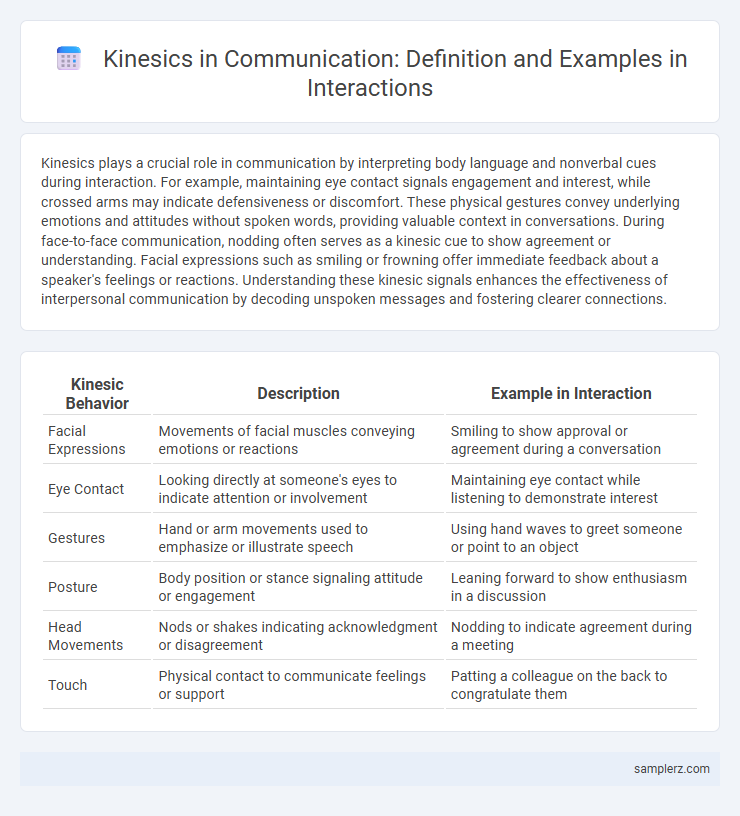Kinesics plays a crucial role in communication by interpreting body language and nonverbal cues during interaction. For example, maintaining eye contact signals engagement and interest, while crossed arms may indicate defensiveness or discomfort. These physical gestures convey underlying emotions and attitudes without spoken words, providing valuable context in conversations. During face-to-face communication, nodding often serves as a kinesic cue to show agreement or understanding. Facial expressions such as smiling or frowning offer immediate feedback about a speaker's feelings or reactions. Understanding these kinesic signals enhances the effectiveness of interpersonal communication by decoding unspoken messages and fostering clearer connections.
Table of Comparison
| Kinesic Behavior | Description | Example in Interaction |
|---|---|---|
| Facial Expressions | Movements of facial muscles conveying emotions or reactions | Smiling to show approval or agreement during a conversation |
| Eye Contact | Looking directly at someone's eyes to indicate attention or involvement | Maintaining eye contact while listening to demonstrate interest |
| Gestures | Hand or arm movements used to emphasize or illustrate speech | Using hand waves to greet someone or point to an object |
| Posture | Body position or stance signaling attitude or engagement | Leaning forward to show enthusiasm in a discussion |
| Head Movements | Nods or shakes indicating acknowledgment or disagreement | Nodding to indicate agreement during a meeting |
| Touch | Physical contact to communicate feelings or support | Patting a colleague on the back to congratulate them |
Understanding Kinesics in Daily Communication
Kinesics, the study of body language, plays a crucial role in daily communication by conveying emotions and intentions without words. For example, maintaining eye contact signals attentiveness and confidence, while crossed arms may indicate defensiveness or discomfort. Understanding these nonverbal cues enhances interpersonal interactions and reduces misunderstandings in various social and professional contexts.
Facial Expressions: Conveying Emotions Nonverbally
Facial expressions serve as a powerful kinesic tool in communication, conveying emotions such as happiness, anger, or surprise without the need for words. Subtle movements of the eyebrows, eyes, and mouth provide clear nonverbal cues that influence social interactions and emotional understanding. Recognizing these expressions enhances emotional intelligence and improves interpersonal communication effectiveness.
Gestures: Enhancing Verbal Messages
Kinesic gestures such as hand movements, nodding, and facial expressions play a crucial role in enhancing verbal communication by providing visual emphasis and clarifying speaker intent. For example, a speaker pointing to an object while describing it helps the listener associate words with physical elements, improving understanding. These nonverbal cues increase message retention and can convey emotions that words alone may fail to express.
Posture and Attitude: Signaling Engagement
Leaning forward with an open posture signals active engagement and interest in the conversation, enhancing interpersonal connection. Maintaining eye contact combined with relaxed shoulders conveys attentiveness and confidence. Conversely, slouching or crossing arms may indicate disinterest or defensiveness, impacting communication effectiveness.
Eye Contact: Building Trust and Connection
Maintaining steady eye contact during communication signals attentiveness and sincerity, fostering trust between individuals. Subtle shifts in gaze can convey empathy or assertiveness, enhancing interpersonal connection. Consistent eye contact strengthens nonverbal cues, making interactions more engaging and meaningful.
Body Orientation: Indicating Interest or Disinterest
Body orientation plays a crucial role in communication by signaling interest or disinterest during interactions. When a person faces another directly, it demonstrates engagement and attentiveness, whereas turning the body away often signifies distraction or lack of interest. Observing these kinesic cues helps decode underlying emotions and improve interpersonal understanding in social and professional settings.
Head Movements: Affirming or Questioning
Nodding the head typically signals affirmation, indicating agreement or understanding during communication. Tilting the head sideways often expresses curiosity or questioning, inviting further clarification. These kinesic head movements play a crucial role in nonverbal interaction by conveying subtle messages without spoken words.
Handshakes: Establishing Greetings and Agreements
Handshakes serve as a universal kinesic behavior in communication, symbolizing greetings and agreements across cultures. The firmness, duration, and style of a handshake convey confidence, trust, and intent during interactions. Specific variations, such as the traditional Western clasp or the two-handed "politician's handshake," reflect underlying social dynamics and relationship nuances.
Microexpressions: Revealing Hidden Feelings
Microexpressions, brief and involuntary facial expressions, reveal true emotions beneath spoken words during interactions. These subtle cues, lasting only a fraction of a second, provide critical insights into a person's genuine feelings, such as fear, anger, or happiness. Understanding and interpreting microexpressions enhances communication by uncovering hidden sentiments that may otherwise go unnoticed.
Cultural Differences in Kinesic Cues
Kinesic cues such as eye contact, gestures, and facial expressions vary significantly across cultures, influencing communication effectiveness and interpretation. For instance, direct eye contact may be perceived as confidence in Western cultures but can be seen as disrespectful or confrontational in some Asian societies. Understanding these cultural differences in kinesic behavior is essential for reducing misunderstandings and enhancing intercultural communication.

example of kinesic in interaction Infographic
 samplerz.com
samplerz.com